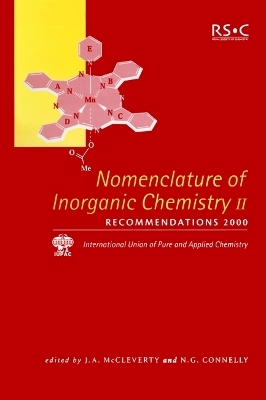
Nomenclature of Inorganic Chemistry II
Royal Society of Chemistry (Verlag)
978-0-85404-487-0 (ISBN)
- Titel ist leider vergriffen;
keine Neuauflage - Artikel merken
Chemical nomenclature has attracted attention since the beginning of chemistry, when the need to exchange knowledge was first recognised. The responsibility for providing nomenclature to the chemical community was assigned to the International Union of Pure and Applied Chemistry, whose Rules for Inorganic Nomenclature were published and revised in 1958 and 1970. Since then many new compounds have appeared, particularly with regard to coordination chemistry and boron chemistry, which were difficult to name using the 1970 Rules. Consequently, the IUPAC Commission on the Nomenclature of Inorganic Chemistry decided to thoroughly revise the last edition of the 'Red Book'. As many of the new fields of chemistry are very highly specialised and require complex nomenclature, the revised edition is in two parts. Whilst Part I is mainly concerned with general inorganic chemistry, this volume, Part II, addresses such diverse chemistry as polyanions, isotopic modification, tetrapyrroles, nitrogen hydrides, inorganic ring, chain, polymer, and graphite intercalation compounds. The recommendations bring order to the nomenclature of these specialised systems, based on the fundamental nomenclature described in Part I and the organic nomenclature publications. Each chapter has been subject to extensive review by members of IUPAC and practising chemists in various areas.
1: General Aims, Functions and Methods of Chemical Nomenclature; 1.1: Introduction; 1.2: History of chemical nomenclature; 1.3: Aims of chemical nomenclature; 1.4: Functions of chemical nomenclature; 1.5: Methods of inorganic nomenclature; 1.6: Changes to previous IUPAC recommendations; 1.7: Nomenclature recommendations in other areas of chemistry; 1.8: References; 2: Grammar; 2.1: Introduction; 2.2: Enclosing marks; 2.3:Hyphens, plus and minus signs, 'em' dashes and bond indicators; 2.4: Solidus; 2.5: Dots, colons, commas and semicolons; 2.6: Spaces; 2.7: Elisions; 2.8: Numerals; 2.9: Italic letters; 2.10: Greek alphabet; 2.11: Asterisks; 2.12: Primes; 2.13: Multiplicative prefixes; 2.14: Locants; 2.15: Ordering principles; 2.16: Final remarks; 2.17: References; 3: Elements;3.1: Names and symbols of atoms; 3.2: Indication of mass, charge and atomic number using indexes (subscripts and superscripts); 3.3: Isotopes; 3.4: Elements (or elementary substances); 3.5: Elements in the periodic table; 3.6: References; 4: Formulae; 4.1: Introduction; 4.2: Definitions of types of formula; 4.3: Indication of ionic charge; 4.4: Sequence of citation of symbols in formulae; 4.5: Isotopically modified compounds; 4.6: Optional modifiers of formulae; 4.7: References; 5: Compositional Nomenclature, and Overview of Names of Ions and Radicals; 5.1: Introduction; 5.2: Stoichiometric names of elements and binary compounds; 5.3: Names of ions and radicals; 5.4: Generalized stoichiometric names; 5.5: Names of (formal) addition compounds; 5.6: Summary; 5.7: References; 6: Parenthydride Names and Substitutive Nomenclature; 6.1: Introduction; 6.2: Parent hydride names; 6.3: Substitutive names of derivatives of parent hydrides; 6.4: Names of ions and radicals derived from parent hydrides; 6.5: References; 7: Additive Nomenclature; 7.1: Introduction; 7.2: Mononuclear entities; 7.3: Polynuclear entities; 7.4: Inorganic chains and rings; 7.5: References; 8: Inorganic Acids and Derivatives; 8.1: Introduction and overview; 8.2: General principles for systematic naming of acids; 8.3: Additive names; 8.4: Hydrogen names; 8.5: Abbreviated hydrogen names for certain anions; 8.6: Functional replacement names for derivatives of oxoacids; 8.7: References; 9: Coordination Compounds; 9.1: Introduction; 9.2: Describing the constitution of coordination compounds; 9.3: Describing the configuration of coordination entities; 9.4: Final remarks; 9.5: References; 10: Organometallic Compounds; 10.1: Introduction; 10.2: Nomenclature of organometallic compounds of the transition elements; 10.3: Nomenclature of organometallic compounds of the main group elements; 10.4: Ordering of central atoms in polynuclear organometallic Compounds; 10.5: References; 11: Solids; 11.1: Introduction; 11.2: Names of solid phases; 11.3: Chemical composition; 11.4: Point defect (Kro" ger-Vink) notation; 11.5: Phase nomenclature; 11.6: Non-stoichiometric phases; 11.7: Polymorphism; 11.8: Final remarks; 11.9: References; Tables; Table I: Names, symbols and atomic numbers of the elements; Table II: Temporary names and symbols for elements of atomic number greater Than 111; Table III: Suffixes and endings; Table IV: Multiplicative prefixes; Table V: Geometrical and structural affixes; Table VI: Element sequence; Table VII: Ligand abbreviations; Table VIII: Structural formulae of selected ligands; Table IX: Names of homoatomic, binary and certain other simple molecules, ions, compounds, radicals and substituent groups; Table X: Anion names, 'a' terms used in substitutive nomenclature and 'y' terms used in chains and rings nomenclature
| Erscheint lt. Verlag | 13.8.2001 |
|---|---|
| Mitarbeit |
Koordination: Terry Renner |
| Zusatzinfo | No |
| Verlagsort | Cambridge |
| Sprache | englisch |
| Maße | 173 x 287 mm |
| Einbandart | gebunden |
| Themenwelt | Naturwissenschaften ► Chemie ► Anorganische Chemie |
| ISBN-10 | 0-85404-487-6 / 0854044876 |
| ISBN-13 | 978-0-85404-487-0 / 9780854044870 |
| Zustand | Neuware |
| Haben Sie eine Frage zum Produkt? |
aus dem Bereich


